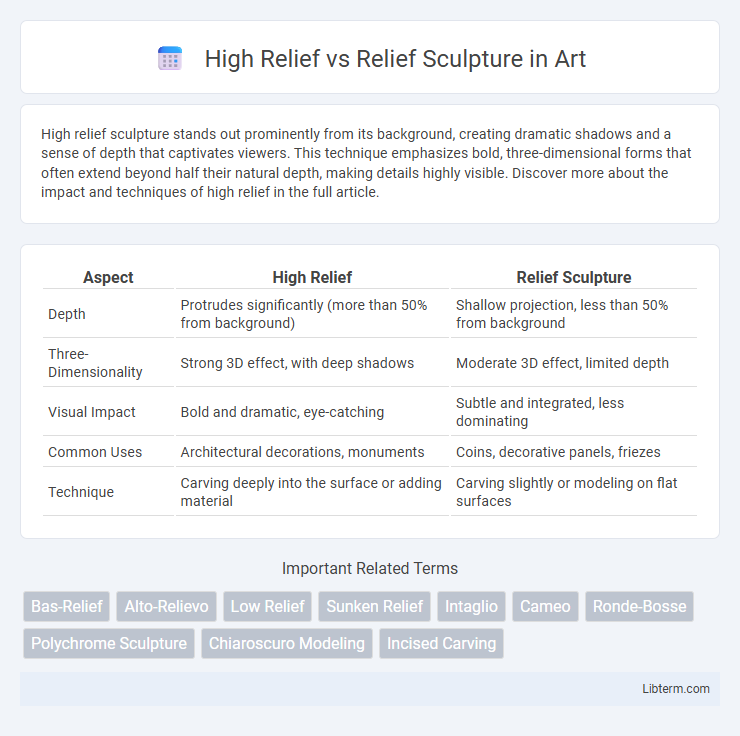High relief sculpture stands out prominently from its background, creating dramatic shadows and a sense of depth that captivates viewers. This technique emphasizes bold, three-dimensional forms that often extend beyond half their natural depth, making details highly visible. Discover more about the impact and techniques of high relief in the full article.
Table of Comparison
| Aspect | High Relief | Relief Sculpture |
|---|---|---|
| Depth | Protrudes significantly (more than 50% from background) | Shallow projection, less than 50% from background |
| Three-Dimensionality | Strong 3D effect, with deep shadows | Moderate 3D effect, limited depth |
| Visual Impact | Bold and dramatic, eye-catching | Subtle and integrated, less dominating |
| Common Uses | Architectural decorations, monuments | Coins, decorative panels, friezes |
| Technique | Carving deeply into the surface or adding material | Carving slightly or modeling on flat surfaces |
Introduction to Relief Sculpture
Relief sculpture is a technique where figures are carved or molded to project from a flat background, creating a raised three-dimensional effect. High relief (alto-relievo) features deeply carved elements that stand out prominently, often by more than half their depth from the background. In contrast, low relief (bas-relief) involves shallow carving where the figures barely rise from the background, making high relief more dynamic and visually impactful.
Defining High Relief Sculpture
High relief sculpture, or alto-relievo, features figures that project prominently from the background, often by more than half their depth, creating a strong three-dimensional effect. Unlike low relief (bas-relief), where the depth is shallow and the figures barely stand out, high relief allows for deep shadows and more dynamic compositions. This technique enhances the visual impact by emphasizing contours and intricate details, making sculptures appear more lifelike and dramatic.
Defining Low Relief and Bas-Relief
Low relief, or bas-relief, is a sculptural technique where the design slightly projects from the background surface, creating subtle depth while maintaining overall flatness. This method contrasts with high relief, which features more pronounced, three-dimensional figures that stand out significantly from the background. Bas-relief is commonly used in coins, architectural decorations, and sculptures where intricate detail is required without full dimensionality.
Key Differences: High Relief vs Relief Sculpture
High relief sculpture features figures that project at least halfway out from the background, creating a strong sense of depth and three-dimensionality, while relief sculpture generally refers to any technique where the sculpted elements remain attached to a solid background. In low relief, or bas-relief, the projection is shallow and the forms are more subtle, whereas in high relief, the pronounced projection casts deeper shadows and allows more dynamic compositions. Key differences include the degree of projection from the background and the visual impact, with high relief offering a more dramatic, sculptural effect compared to the flatter appearance of typical relief sculpture.
Historical Origins and Cultural Significance
High relief sculpture, characterized by figures deeply carved to project boldly from the background, traces its origins to ancient Mesopotamian and Egyptian art, where it conveyed divine and royal authority. Relief sculpture, including low relief or bas-relief, was widely used by civilizations such as the Greeks and Romans to narrate historical events and mythologies on architectural monuments and public buildings. Both forms played pivotal roles in cultural expression by visually communicating societal values, religious beliefs, and political power across diverse historical contexts.
Techniques Used in High Relief Sculpture
High relief sculpture involves deeply carving figures that project significantly from the background, often by more than half their depth, creating a dramatic interplay of light and shadow. Techniques used in high relief include undercutting to enhance depth perception and the use of varied textural details to emphasize three-dimensionality and dynamic movement. Sculptors employ chisels, rasps, and fine carving tools to achieve precise contours and intricate layering that distinguish high relief from low relief sculptures.
Techniques Used in Low Relief Sculpture
Low relief sculpture, also known as bas-relief, involves shallow carving where the sculpted elements slightly project from the background, creating subtle depth and detail. Techniques used in low relief include incising, where lines are cut into the surface, and undercutting, which enhances shadows and highlights without fully detaching the forms from the base. Artists often employ chisels, rasps, and polishing tools to achieve smooth transitions and fine textures integral to this technique.
Famous Examples of High Relief Sculptures
High relief sculptures, characterized by figures that project prominently from the background, provide a dramatic and dynamic visual effect compared to low relief, where the projection is shallow. Famous examples of high relief sculptures include the Parthenon Frieze in Athens, showcasing intricate mythological scenes, and Donatello's "Saint George," which emphasizes detailed, three-dimensional forms. These masterpieces highlight the depth and realism achievable through high relief techniques, enhancing narrative and emotional impact.
Notable Relief Sculpture Masterpieces
High relief sculptures, such as the Parthenon Frieze, feature deeply carved figures that project prominently from the background, creating dramatic shadows and a sense of three-dimensionality. In contrast, low relief sculptures like the Trajan's Column display shallower carvings that remain closely attached to the flat surface, emphasizing intricate detail over depth. Iconic masterpieces exemplify each style, with the high relief of the Angkor Wat bas-reliefs and the low relief on the Ara Pacis Augustae showcasing the artistic versatility of relief sculpture throughout history.
Choosing the Right Relief Technique for Artistic Expression
High relief sculpture projects significantly from the background, often exceeding half the depth of the figures, creating dynamic shadows and a strong three-dimensional effect. In contrast, relief sculpture includes varying depths, from low to bas-relief, allowing subtle depth and detail on a flatter surface. Artists should select the technique based on desired visual impact and expressive depth, with high relief suited for dramatic, bold statements and low relief ideal for intricate, delicate designs.
High Relief Infographic

 libterm.com
libterm.com